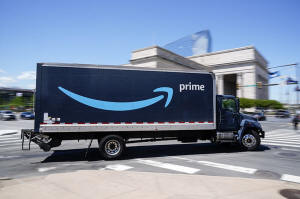Amazon reports strong earnings for Q4, but stocks dip due to outlook for
the first quarter
 Send a link to a friend
Send a link to a friend
 [February 07, 2025] By
HALELUYA HADERO [February 07, 2025] By
HALELUYA HADERO
Amazon on Thursday reported better-than-expected revenue and profits for
the holiday shopping period, but its stocks dipped in after-hours
trading due to disappointing guidance for the current quarter.
The Seattle-based e-commerce and technology company said its revenue for
the October-December period totaled $187.8 billion, a 10% jump compared
with the same period in 2023. Profits came out to $20 billion while
earnings per share reached $1.86, higher than the $1.49 that analysts
surveyed by FactSet had anticipated.
But the company said it expected revenue for the current quarter to be
between $151 billion and 155.5 billion, lower than the $158.56 billion
that analysts were expecting. The guidance anticipates “an unusually
large, unfavorable impact” from foreign exchange rates, it said.
Amazon is the biggest online shopping destination in the U.S. and has
long been a beneficiary of consumer spending during the holidays. As it
has done in recent years, the company in October began offering
promotions intended to lure early holiday shoppers. It advertised other
discounts during the three-month period, including on major sales days
such as Black Friday and Cyber Monday.
Amazon on Thursday reported it saw $75.5 billion in revenue for its
online shopping business, up 7% from the same period in 2023.

Across the retail industry, holiday sales in November and December were
better than expected compared with the previous year as lower inflation
on holiday goods enticed shoppers to buy, according to The National
Retail Federation. Online shopping also saw record sales levels, Adobe
Analytics reported in January.
Sales for Amazon Web services, the company’s prominent cloud computing
unit, rose 19% during the fourth quarter. But it fell slightly below
analysts expectations.
Amazon is one of the biggest players in the competitive tech race around
generative artificial intelligence. Like other tech companies, it has
ramped up investments in the technology and is spending billions to
expand data centers that support AI and cloud computing. The company is
also spending money on other equipment, including its own computer chips
and those developed by Nvidia. It has also rolled out its own AI models
and integrated the generative AI into other parts of its business.
[to top of second column] |

An Amazon truck drives in in Philadelphia, Friday, April 30, 2021.
(AP Photo/Matt Rourke, file)
 In the fourth quarter, Amazon
reported spending $27.8 billion on property and equipment,
significantly higher than the same period in 2023. During a call
with analysts on Thursday, Amazon CEO Andy Jassy said capital
expenditures for the quarter came out to $26.3 billion, most of
which was geared towards AI and AWS.
“We think virtually every application that we know of today is going
to be re-invented with AI inside of it,” Jassy said. “I think both
our business, our customers and shareholders will be happy
medium-to-long term that we're pursuing the capital opportunity and
the business opportunity in AI.”
Jassy added during the call that Amazon, like many others, was
“impressed” by DeepSeek, the Chinese artificial intelligence company
whose chatbot recently became the most downloaded app in the U.S.
Amazon's quarterly report comes as the retail industry is absorbing
a new 10% tariff President Donald Trump imposed on Chinese imports
on Tuesday. Tariffs on Canada and Mexico have been put on hold for
about a month.
Trump also threw out a trade exemption that allowed low-value
shipments from China to bypass duties, a loophole that had given an
advantage to China-founded e-commerce firms, such as Shein and Temu.
The new tariffs could benefit Amazon by increasing costs for its
competitors. But it would also impact Chinese sellers who connect
with American consumers on the company’s shopping platform.
Furthermore, it could raise prices on a recently-launched online
storefront that Amazon set up to ship low-cost products directly
from China. The storefront, called Amazon Haul, was Amazon’s answer
to Shein and Temu.
Additionally, analysts from Morgan Stanley wrote in a Monday note
that Amazon's first-party retail business, though which the company
sells products purchased from manufacturers, has the highest
exposure to the tariffs. The analysts estimate 25% of the
merchandise sold through that business comes from China.
All contents © copyright 2025 Associated Press. All rights reserved |